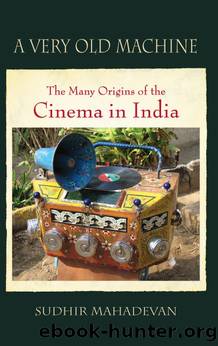A Very Old Machine by Sudhir Mahadevan

Author:Sudhir Mahadevan [Mahadevan, Sudhir]
Language: eng
Format: epub
ISBN: 9781438458304
Publisher: SUNY Press
Published: 2015-07-15T05:00:00+00:00
PHOTO-ILLUSTRATIONS AND FILM
What political salience do these mundane ethnographic and picturesque modes carry? The dilution of a âcolonial sociology of knowledgeâ (Cohn 1996) by the snapshot and the halftone underscored a complex relation between the public and the private, a relation the cinema would play a crucial role in politicizing, as we shall see in the subsequent chapter. The hand cameraâs marketing and uses in the United States produced a clear distinction between the public and the private. This distinction is predicated on a further division of representation between the halftone (the public mass image) and the family snapshot (the private moment). Kodakâs marketing ultimately defined the snapshot as a selection of significant private moments for the family album, and public life became the domain of the newspaper halftone (Savras and Frohlich 2011, 63â66). This had not always been the case, for in the preâhand camera days, public figures and events used to be routinely included in family albums. Thus, the eventual separation of public figures and events from private figures and events implied a distinction, to put it somewhat simplistically, between the political and the personal.
These two sets of distinctions cannot, however, be taken for granted in British India. For one could argue that the halftone image of the early-twentieth-century newspaper turned the public sphere into an object of private consumption for the European reader. For the European, the private was not restricted to the family album. It included an entire people, the public property of empire reproduced as image for private leisurely consumption.
This interchangeability of domains mirrored the mode of photojournalistic production. A glance at photo-illustrations in newspapers such as The Statesman and the Illustrated Weekly of India makes clear that amateur snapshotters supplied a significant portion of the images published in newspapers, and newspapers sought out these images. Hence, the JPSI thought it worthwhile to proffer advice on amateursâ contribution to photojournalism with specific reference to India.14
The example of the Delhi Durbars (1877, 1902/03, and 1910/11) illuminates the way in which the public and private were metonymic in significance and experience for Europeans. The Durbars were borrowed from Mughal and other South Asian courtly traditions and reinvented by the British. Their original function was to serve as rituals of gift giving and receiving that established hierarchy between the king, his subordinates, and the subjects at large. The giving and receiving of cloth was the most important of the Durbarâs rituals. It signified an incorporation of the body of the subject into the kingâs body. It was this tradition that the British borrowed and enacted three times, in 1877, 1902/03, and 1911/12. All three Durbars were multimedia events involving photographers, filmmakers, and newspaper journalists. The first one of the twentieth century, in 1902/03, attracted British film producer R. W. Paul, who made at least four films of the Durbar; the Gaumont film company, which may have hired the services of Bourne & Shepherd (the famed photography studio of Calcutta and Simla) to do the actual photographing; the American
Download
This site does not store any files on its server. We only index and link to content provided by other sites. Please contact the content providers to delete copyright contents if any and email us, we'll remove relevant links or contents immediately.
Aircraft Design of WWII: A Sketchbook by Lockheed Aircraft Corporation(31772)
The Great Music City by Andrea Baker(21283)
Call Me by Your Name by André Aciman(18964)
The Art of Boudoir Photography: How to Create Stunning Photographs of Women by Christa Meola(17841)
Shoot Sexy by Ryan Armbrust(17141)
Plagued by Fire by Paul Hendrickson(16636)
The Secret History by Donna Tartt(16622)
Portrait Mastery in Black & White: Learn the Signature Style of a Legendary Photographer by Tim Kelly(16484)
Adobe Camera Raw For Digital Photographers Only by Rob Sheppard(16387)
Photographically Speaking: A Deeper Look at Creating Stronger Images (Eva Spring's Library) by David duChemin(16161)
Bombshells: Glamour Girls of a Lifetime by Sullivan Steve(13108)
Pimp by Iceberg Slim(12931)
Ready Player One by Cline Ernest(12837)
The Goal (Off-Campus #4) by Elle Kennedy(12432)
Art Nude Photography Explained: How to Photograph and Understand Great Art Nude Images by Simon Walden(12348)
Kathy Andrews Collection by Kathy Andrews(10519)
Thirteen Reasons Why by Jay Asher(7788)
Wonder by R.J. Palacio(7732)
Goodbye, Things by Fumio Sasaki(7728)
